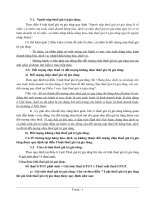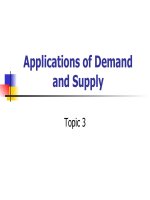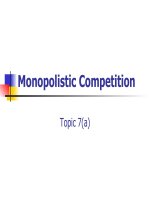Bài giảng topic 7(a) monopolisstic competition
Bạn đang xem bản rút gọn của tài liệu. Xem và tải ngay bản đầy đủ của tài liệu tại đây (210.3 KB, 15 trang )
Monopolistic Competition
Topic 7(a)
Contents
1. Characteristics of MC
2. Short run profit maximisation
3. Long run equilibrium
4. Assessment of MC
5. Product differentiation and Advertising
Characteristics of MC
Large number of small firms
so individual decisions have little or no
impact on other firms’ decisions
Differentiated products
similar but not identical
Low barriers to entry
low economies of scale
low set-up costs
Price and Output Determination
The Firm’s Demand Curve in MC is:
Highly elastic, Why?
More close substitutes than a pure monopolist
Not perfect substitutes (as is the case with
perfect competition)
Elasticity depends on
number of rivals
degree of product differentiation
Short-Run Price and Output
Determination
Rules for Profit maximization same as
under Perfect Competition
MR = MC (where MC cuts MR from below)
Short Run: P ≥ AVC
Long Run : P ≥ ATC
Economic
Profits
Short-Run Price and Output
Determination: Short-Run Profits
Q
D
P
Price and Costs
MR
MC
Q
AC
Losses
Q
D
P
Price and Costs
MR
MC
Q
ATC
Short-Run Price and Output
Determination: Short-Run Losses
Long Run
How much to produce?
MR = MC
Firms tend to break even, i.e. normal
profit
Tangency solution: profit-maximising firm will
produce an output when its demand curve is
at a tangent to its ATC curve
When ATC = Price
Long run Equilibrium
Long-Run Equilibrium
Why do monopolistically competitive firms
tend
to break even in the long run?
Profits attract new entrants
Losses encourage exits
Some complications
Some product differentiation
Some entry is partially restricted
Some economic losses may be tolerated by
firms in the long run
Assessment of MC (vs. PC)
Higher price, lower
output
lower consumer
surplus
like monopoly
P > MC
No allocative eff.
P = AC
like PC but
P ≠ min AC
No productive eff.
Monopolistic Competition &
Economic Efficiency
Productive inefficiency
: Minimum ATC
is not necessarily chosen
excess capacity
Allocative inefficiency
:
price does not necessarily equal MC
Good feature
product variety
Non-price Competition
(ie. competition not based on price)
Product differentiation:
Real and/or perceived differences created by factors such as:
quality, brands, service, location, advertising and packaging
Advantages
More choice
Innovation => Better products
Avoid price war
Disadvantages
Too much choice?
Superficial product changes – waste of resources
Non-price Competition -
Advertising
Firm
Advantages of Advertising
influences consumer preferences (the power of
persuasion)
makes demand more price inelastic
Increases market power, market share
Disadvantages of Advertising
Increases cost of production
Non-price Competition –
Advertising (cont.)
Society
Advantages of Advertising
Provides information
Promotes competition
Advertising revenue – cheaper media (television,
newspapers etc) for users
Disadvantages of Advertising
Misleading or false information
Waste of resources if overall market demand stays
constant
Creates barriers to entry (financial, brand loyalty)
Media bias towards advertisers









